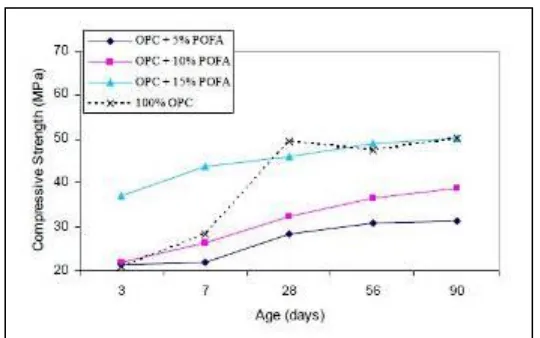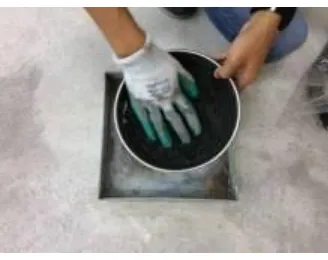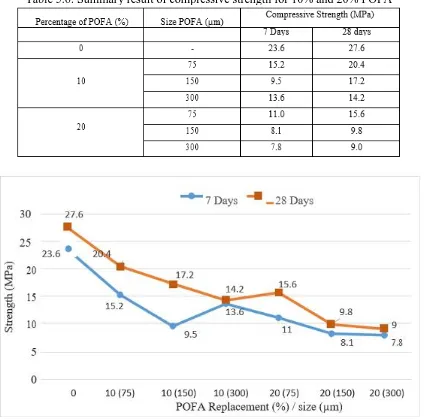Construction Materials and Technology Series 1 2018 ISBN 978-967-2183-19-8
65
CHAPTER 5
THE PERFORMANCE ON CONCRETE BRICK CONTAINING PALM
OIL FUEL ASH (POFA) AS REPLACING CEMENT
Tarmidzi Mohd Zailani1, Suraya Hani Binti Adnan1, Mohd Sufyan Bin Abdullah1
Faculty of Engineering Technology
,
Universiti Tun Hussein Onn Malaysia
,
Parit Raja,
Batu Pahat,
86400 Johor
,
Malaysia.
5
.
1 INTRODUCTION
Construction field is a field that is wider than the other fields. The construction is becoming increasingly rapidly to meet the growing population. In the field of construction, brick is an essential element to construct a building. Production of concrete leads to a reduction in natural resources as materials used in producing a concrete brick example of fine aggregate and cement. Furthermore, this problem gets attention from some parties in finding an alternative to reduce waste and maintained the natural resources to produce concrete using waste materials. Therefore, waste materials will be used in the concrete mix to reduce landfill and can reduce biomass waste.
As in Malaysia, palm oil industry which is the major agro-industry in this country has been generating large amount of waste which becomes one of the main contributor to the nation’s pollution problem [1]. Oil Palm Shell (OPS) and Palm Oil Fuel Ash (POFA) produced from the industry has been dumped in the vicinity of palm oil mill. Improper disposal of the vast quantity of POFA which has been produced may contribute to environmental problem in future [2]. Similarly, dumping oil palm shell in open area to biodegrade may take long time and consume more space to be allocated for the disposal of this by-product which would increase the cost of palm oil mill in managing this waste. Thus, these problems have driven researchers to figure out possible solution such as utilizing palm oil by product in concrete production.
Construction Materials and Technology Series 1 2018 ISBN 978-967-2183-19-8
66
determining the compressive strength and water absorption of concrete brick that contains palm oil fuel ash (POFA) by execute lab test. The test conducted with different substitution percentage of POFA which is 0%, 10% and 20% by replacing cement in the concrete. POFA that obtained from palm oil factory need to pass the sieve analysis test that classified into three group of size which is 300 µm, 150 µm and 75 µm.
5.2 LITERATURE REVIEW
Palm oil industry is one of the major agro-industries in countries like Malaysia and Thailand. This industry produces a large amount of waste in the forms of empty fruit bunches, fibres and kernels. These by-products are normally used as fuel to heat up boiler for generation of electricity in palm oil factories. The ash derived from the process has been known as palm oil fuel ash (POFA). Realizing the potential pozzolanic property of POFA coupled with aims at reducing the potential environmental problems associated with disposing of POFA, alleviating the negative implications normally linked to cement production especially green-house gasses mission and preserving the non-renewable natural resources for producing cement, many researchers have attempted to utilize POFA as pozzolanic mineral admixture in concrete.
PROPERTIES OF POFA
The utilization of POFA was also observed to improve the resistance of concrete to chloride ion penetration [3] reduce heat development, increase resistance to acidic environment and improve sulphate resistance of concrete [4]. According to [5], POFA as shown in Figure 5.1 has low pozzolanic characteristics, and its use should not exceed 10% by cement mass when used in partial substitution to cement. POFA had good potential to suppress expansion associated with alkali-silica reaction in concrete [6]. Other previous studies assert that it is not possible to produce concrete containing POFA in the excess of 30% by cement mass [6].
Figure 5.1: Palm oil fuel ash
Construction Materials and Technology Series 1 2018 ISBN 978-967-2183-19-8
67
[image:3.597.159.454.146.625.2]Loss on ignition³ basically refers to the carbon content in the ash. The more carbon that is still present, the more weight you will lose upon burning the ash. Ideally, there should be no weight loss at all. As little as 3% of coal in the cement mix (without aggregates) will prevent the hardening of the concrete. On the other hand, 1% doesn¹t seem to be a problem at all, so the gap is pretty narrow.
Table 5.1: Chemical composition of POFA [3]
Chemical Composition (%)
Silicon Dioxide (SiO2) 49.20
Aluminum Oxide (Al203) 5.45
Ferric Oxide (Fe2O3) 5.73
Calcium Oxide (CaO) 7.50
Magnesium Oxide (MgO) 3.93
Sulphur Trioxide (SO3) 1.73
Sodium Oxide (Na2O) 0.90
Potassium Oxide (K2O) 5.30
Phosphorus Pent oxide
(P2O5) 6.41
[image:3.597.179.409.162.376.2]Loss on Ignition (LOI) 13.85
Table 5.2: Chemical Composition of Class F Fly Ash [10]
Substance or Property Requirements (ASTM
C 618), %
SiO2 plus Al2O3 plus Fe2O3,
min 50
SO3, max. 5
Moisture content, max. 3
Loss on ignition, max. 6
Source:
Table 5.3: Chemical Composition of Class F Fly Ash [10]
Substance or Property Requirements (ASTM C
618), %
SiO2 plus Al2O3 plus Fe2O3, min 70
SO3, max. 5
Moisture content, max. 3
Loss on ignition, max. 6
COMPRESSIVE STRENGTH
Construction Materials and Technology Series 1 2018 ISBN 978-967-2183-19-8
[image:4.597.189.459.91.260.2]68
Figure 5.2: Compressive strength versus age for different level of POFA
In this study, it was shown that replacement of POFA's in concrete mixtures as binders will cause the rate of early strength increased and becomes slower at later age. This is due to calcium hydroxide content from hydration process was diminished through reaction with silica dioxides composition in pozzolans. The efficiency of this mechanism applies to the chemical compositions of pozzolans. This mechanism is clearly seen in earlier pozzolans reaction observed by numerous researchers. However, this mechanism is complicated and relies upon many factors such as microstructures and chemical composition. It should be reminded that as the amount of replacement cement increases, the amount of OPC decreases as the amount of binders is fixed. However, this mechanism is clear for addition of pozzolans without reducing any OPC content. As replacement series replace the amount of OPC and this will reduce some chemical constituent in OPC the mechanism might be different largely depends on chemical composition of pozzolans.
There are optimum amounts of cement replacement that can obtain higher pozzolans concrete strength as other essential chemical composition and heat exerted from hydration process in OPC that contributes to full hydration process and gave extra interlocking bond between the aggregate and cement paste for concrete became stronger. From both points, there are amounts of POFA replacement that produce not only higher but denser concrete. Fly ash obtained its optimum strength by replacing 10% of its OPC content [9]. Yet, at later ages, concrete compressive strength of concrete containing POFA increases. This is might due to reaction between C3S, constituent of cement that contributes to long-term strength of the concrete. This, however need to be verify through microscopic visual test.
From the figure above, 15% of POFA in concrete mixture produces concrete the strength of 48MPa, the same strength obtained by control mixture. The compressive strength obtained by 5 and 10 percent of POFA gave compressive strength less than targeted strength of 40 MPa. This shows that replacement of 15 percent gave optimum strength which is the same strength obtained by the control concrete.
WATER ABSORPTION
Construction Materials and Technology Series 1 2018 ISBN 978-967-2183-19-8
69
weighing it, immersing it in water for specified amount of time, and weighing it again. The increase in weight as a percentage of the original weight is expressed as its absorption (in percent). The average absorption of the test samples shall not be greater than 12% [10].
5.3 METHODOLOGY
[image:5.597.101.499.242.320.2]A total of 84 units of concrete brick size of 102.5 mm x 215 mm x 65 mm were prepared for each mixture and test for compressive strength and water absorption. The total ratio and value of palm oil fuel ash (POFA), cement and sand in concrete mixture are shown in Table 5.4 and Table 5.5.
Table 5.4: Mix proportion ratio of concrete mix
Mixture Mix proportion ratio POFA percentage
(%)
Cement Fine aggregate w/c ratio
1 1 3 0.5 0.5
2 0.9 3 0.5 0.5
3 0.8 3 0.5 0.5
Table 5.5: The total weight of POFA as replacement material of cement in concrete mix for per trial mix 1.43×10-3 m3
Mixture Percent
of POFA
Size of POFA (μm)
Weight of cement for 6 samples (kg)
Weight of POFA for 6 samples (kg)
1 1 - 4.28 -
2 10
75 3.84 0.42
150 3.84 0.42
300 3.84 0.42
3 20
75 3.42 0.84
150 3.42 0.84
300 3.42 0.84
Figure 5.3 shows a flow chart showing the procedure in conducting experiments. Materials used in the concrete mix are palm oil fuel ash, cement, fine aggregate, and water as shown in Figure 5.4.
Preapared mix design concrete and materials
Sieve analysis
Sieve POFA size of (75 µm, 150 µm, 300 µm)
[image:5.597.184.430.556.741.2]Laboratory Test Compression Tesr Water Absorption Test
Construction Materials and Technology Series 1 2018 ISBN 978-967-2183-19-8
[image:6.597.128.463.105.351.2]70
Figure 5.4: Materials
Sieve analysis is a process to divide palm oil fuel ash into three particle sizes of 75 µm, 150 µm and 300 µm. The purpose is to determine the optimum strength of concrete brick with different size of POFA. The process of sieve analysis test is shown in Figure 5.5.
Figure 5.5: Sieve Analysis Test
[image:6.597.239.403.423.553.2]Construction Materials and Technology Series 1 2018 ISBN 978-967-2183-19-8
71
[image:7.597.55.519.174.518.2]Compressive strength test is determining the strength and durability of the concrete. This test was performed by referring to BS 1881: Part 116: 1983 (Determination of compressive strength of concrete cubes). The compression test was performed at 7 and 28 days. Concrete bricks are placed at compression machine before the load was applied gradually without shock and continuously at the rate of 140 N/mm2/minute till the concrete cube fails as shown in Figure 5.7.
Figure 5.6: Compression Test
Figure 5.7: Water Absorption Test
5.4 RESULTS AND DISCUSSIONS
The result of compressive strength of brick by using 10% and 20% palm oil fuel ash as replacing cement with various size of palm oil fuel ash are detailed in Table 5.6. From the line graph in Figure 5.8, it shows that the sample with replace of POFA by 10% for size 75µm has the highest compressive strength at 28 days compared to the other size and percentage of POFA. The relationship between compressive strength of brick and percentage of POFA replacement which compressive strength has increases positive correlation due to size for all different replacement of POFA under the curing age compressive strength of brick is developed fully predict to 28 days is maximum strength of brick.
Construction Materials and Technology Series 1 2018 ISBN 978-967-2183-19-8
72
[image:8.597.89.513.172.591.2]improvement in the bond between the hydrated cement matrix and fine aggregate. The calcium hydroxide (Ca(OH)2) generated from the hydration process were used during pozzolanic reaction leading to the formation of a secondary calcium silicate hydrate (C-S-H) gel. This gel fills in the voids of brick internal structure that it turns enhances strength of brick through densification of structure.
Table 5.6: Summary result of compressive strength for 10% and 20% POFA
Figure 5.8: Summary result of compressive strength for 10% and 20% POFA
Construction Materials and Technology Series 1 2018 ISBN 978-967-2183-19-8
73
[image:9.597.89.505.216.382.2]According to Figure 5.9 shows the result of water absorption for mix with 10% of POFA size 75 µm at 7 days gives 14.47% and 28 days gives 10.82% while mix with 20% of POFA size 75 µm at 7 days gives 16.52% and 28 days gives 21.92%. Mix with 10% of POFA size 150 µm at 7 days gives 16.77% and 28 days gives 13.67% while mix with 20% of POFA size 150 µm at 7 days gives 21.52% and 28 days gives 22.78%. Also mix with 10% of POFA size 300 µm at 7 days gives 16.88% and 28 days gives 16.01% while mix with 20% of POFA size 300 µm at 7 days gives 17.97% and 28 days gives 22.23%.
Table 5.7: Water absorption at different percentage and size of POFA at 7 and 28 days
Percentage of POFA
(%) Size POFA (µm)
Compressive Strength (MPa)
7 Days 28 days
0 - 7.71 11.36
10
75 14.47 10.82
150 16.77 13.67
300 16.88 16.01
20
75 16.52 21.92
150 21.52 22.78
300 17.97 22.23
It can be concluded that, percentage of POFA is more suitable since the water absorption is much lesser, which is 10.82% at 28 days compared with control which is 11.36 at 28 days. The reason because POFA particles were more porous and possessed a greater specific surface due to the pozzolanic reaction of POFA also the incorporation reduces the pore size in brick due to pore refinement.
[image:9.597.86.513.476.729.2]Construction Materials and Technology Series 1 2018 ISBN 978-967-2183-19-8
74
5.5 CONCLUSIONS
The main objective of this study to identify the physical and mechanical properties of Palm Oil Fuel Ash (POFA) as cement replacement material in the percentage 10% and 20% on compressive strength and water absorption. It can be concluded that all the objective was achieved consequently the results and conclusion and recommendation has been summarized.
Based on the results obtained, it can be concluded POFA of less than 20% as a cementations material enhanced the compressive strength of concrete compared to the samples without POFA in their compositions. Compressive strength and water absorption of palm oil fuel ash shows its optimum at 10% of POFA replacement.
During this study it shows that 10% and 20% replacement of POFA with different size of POFA which is 75 µm acceptable value of strength which is all samples pass the standard American Society for Testing and Materials (ASTM) c129 for non-load bearing and ASTM c90 with minimum requirement 3.45 MPa and 11.7 MPa. Replacement POFA with percentage 20% for size 150 µm and 300 µm only pass for standard ASTM c129 which is for non-load bearing used.
Replacement POFA in brick with the percentage 10% with size of 75 µm exhibits the high result of compressive strength of brick which is 20.4 MPa because upon the inclusion of 10% POFA as partial cement replacement promotes better hydration process and pozzolanic reaction that lead to the generation of a larger C-S-H gel which is the gel occupies the existing voids in brick making it denser and stronger.
The water absorption result is optimum at 10% cement replacement with POFA with size of 75 µm which is 10.82%. This is due to the pozzolanic reaction which caused the pore size structure of the mix to change from coarser pores to finer pores which reduce the entering water into concrete. The water absorption with 10% POFA replacement also give the lower value than control samples.
As a conclusion by using 10% of POFA replacement with size of 75 µm give the best result in compressive strength which is have the higher value of strength, 20.4 MPa even lower than control samples, and the lower percentage of water absorption, 10.2% compared to other percentage and control samples.
ACKNOWLEDGEMENT
Construction Materials and Technology Series 1 2018 ISBN 978-967-2183-19-8
75
REFERENCES
[1] Teo, D.C.L., M.A. Mannan and V.J. Kurian, (2006). Structural concrete using Oil Palm Shell (OPS) as lightweight aggregate. Turk. J. Eng. Environ. Sci., 30: 251-257.
[2] Megat Johari, M.A., A.M. Zeyad, N. Muhammad Bunnori and K.S. Ariffin, (2012).
Engineering and transport properties of high-strength green concrete containing high volume of ultrafine palm oil fuel ash. Constr. Build. Mater., 30: 281-288. Neville, A.M.,2005.
Properties of Concrete.
[3] A.S.M. Abdul Awal & M. W. Hussin. (2010). Strength, Modulus of Elasticity and Shrinkage Behaviour of POFA Concrete. Malaysian Journal of Civil Engineering 21, 2009, Volume 2, Pg 125-134.
[4] Sata V, Jaturapitakkul C, Kiattikomol K. (2004). Utilization of palm oil fuel ash in highstrengthconcrete. J Mater Civ Eng 2004;16(6):625–8.
[5] Tayfun Çiçek & Yasin Çinçin. (2015). Use of Fly Ash in Production of Light-WeightBuilding Bricks. Construction and Building Materials, 2015, Volume 94, Pg 521–527.
[6] A.S.M. Abdul Awal & M. W. Hussin. (2009). Strength, Modulus of Elasticity and Shrinkage Behaviour of POFA Concrete. Malaysian Journal of Civil Engineering 21, 2009, Volume 2, Pg 125-134.
[7] Awal, A.S.M.A. and Hussin, M.W. (1997). Some aspects of durability performances of concreteincorporating palm oil fuel ash, Proceedings of the 5th International Conference on Structural Failure, Durability and Retrofitting, Singapore, Nov. 1997, pp.210-218.
[8] Targan, S., Olgun, A., Erdogan, Y., Sevinc, V. (2003). “Influence of Natural Pozzolan, Colemanite Ore Waste, Bottom Ash, and Fly Ash on the Properties of Portland
Cement.”Journal of Pergamon. Vol. 33. pp 1175-1182.
[9] M. Neville, (1995). Properties of Concrete – Fourth Edition.Longman.
![Table 5.2: Chemical Composition of Class F Fly Ash [10] Requirements (ASTM](https://thumb-us.123doks.com/thumbv2/123dok_us/8751762.892056/3.597.179.409.162.376/table-chemical-composition-class-fly-ash-requirements-astm.webp)





